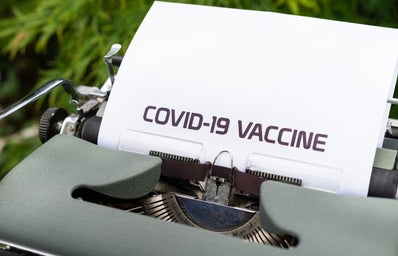It has now been 11 strenuous months since this demonic little coronavirus latched onto our lives and took control. We’ve gotten extensively used to pandemic life as the new necessary normal that affects every aspect of our lives and interactions with others. However, the Pfizer-BioNTech and Moderna vaccines have successfully been authorized for emergency use and are currently being injected into the arms of many civilians across the globe. With the continuous news of new promising vaccines being successfully administered, is it safe to have hope that unrestrained and unmasked life will make a comeback before the new year ends? The glorious and welcoming light at the end of the long, dark and lonely tunnel shines brighter and brighter every day a new person is protected from the coronavirus. Despite this, the end is still unknown, blurred by the hysteria of current events and uncertainty surrounding the vaccines’ reliability.
According to the CDC, as of Jan. 14, 30,628,175 total doses of the vaccines have been distributed, and 11,148,991 total doses have been administered in the United States. Of those administered vaccines, 6,525,252 were the Pfizer-BioNTech vaccine, and 4,620,722 were the Moderna vaccine. Both vaccines are mRNA vaccines that require two doses. The Pfizer vaccine requires the two doses to be 21 days apart and is recommended for people aged 16 years and older. Meanwhile, the Moderna vaccine requires the two doses to be 28 days apart and is recommended for people 18 years and older. The Pfizer vaccine is 95%, and the Moderna vaccine is 94.1% effective. Both vaccines come with warnings to those who experience severe allergic reactions to any of the vaccines’ ingredients. While both vaccines have been moderately harmless so far with only mild possible side effects, allergy-susceptible individuals are advised to take serious caution. If enough people have bad reactions to these vaccines, the likelihood of other people deciding to get vaccinated will decrease. Nevertheless, with the ongoing success of both vaccines, the U.S. has rolled out a new COVID-19 Vaccination Program to get as many at-risk people vaccinated as possible while supplies last in an organized and trackable fashion.

The U.S. COVID-19 Vaccination Program is administering the very first COVID-19 vaccines to be authorized and approved for usage. It is important to note that these vaccines have not gone through the full lengthy process of multiple clinical trials that most other vaccines have. These COVID-19 vaccines are being used under the FDA’s Emergency Use Authorizations (EUA), which supports the use of successful, promising and so far, effective vaccine contenders for emergency purposes. This means that the vaccines have gone through a minimal amount of clinical testing to be legally and safely administered to civilians. This by no means diminishes the safety of the vaccine, but it does leave an extent of uncertainty in the long-term reliability and success of the vaccine. With 23.3 million total cases of COVID-19 and 388,785 total deaths caused by the virus as of Jan.15, this is undoubtedly an emergency that justifies the FDA’s emergency approval that these vaccines get produced and dispersed as rapidly, extensively and safely as possible.
For those who have already received their doses of the vaccine, the CDC has developed v-safe, a smartphone-based post-vaccination health checker. This helps the CDC ensure that the vaccines have as minimal safety issues as possible. As there are limited initial supplies of the vaccine, the CDC and the Advisory Committee on Immunization Practices must dictate how and who to distribute the limited resource to. The CDC has decided to give out the vaccine in phases based on groups of prioritized individuals whose vaccination should be imminent. Phase 1a consists of healthcare personnel and long-term care facility residents. Phase 1b consists of essential frontline workers and people 75 years of age and older. Phase 1c consists of people ages 65 through 74 as well as people ages 16 through 64 who have underlying medical conditions and any other essential workers. The underlying conditions in which these vaccines have been clinically tested to protect against COVID-19 include lung disease, heart disease, obesity, diabetes, liver disease or HIV infection. While the end goal of the U.S. COVID-19 Vaccination Program is for everyone to be easily vaccinated, this will only be achievable once larger quantities are readily and widely available, which could take weeks or months. Unlike many prescriptions and vaccinations provided by the American healthcare system, the CDC promises that cost is not an anticipated issue. They explain that vaccine doses are purchased by U.S. taxpayer dollars and will thus be given to Americans at no cost. However, additional administration fees may apply depending on the vaccination provider. This fee can be covered by an individual’s private or public insurance company, and uninsured Americans can be covered by the Health Resources and Services Administration’s Provider Relief Fund.

While we watch healthcare workers, elderly people and politicians get their vaccinations and wait for our turn, we are advised to follow the CDC’s guidelines for preventing the spread. These vaccines have brought peace to those risking their lives every day to stopping the spread as well as to those for which COVID-19 could be the end. Although it may take months, until the end of 2021 or well into 2022, to vaccinate as many Americans as possible, it could take years and decades for the world to recover from this biological disaster. To defeat COVID-19, herd immunity is essential, and slowly but surely, we will unhook the suffocating grasp the coronavirus has on our world for good.
Want to see more HCFSU? Be sure to like us on Facebook and follow us on Instagram, Twitter, TikTok, Youtube and Pinterest!



